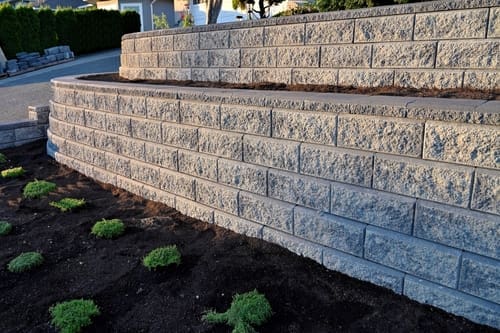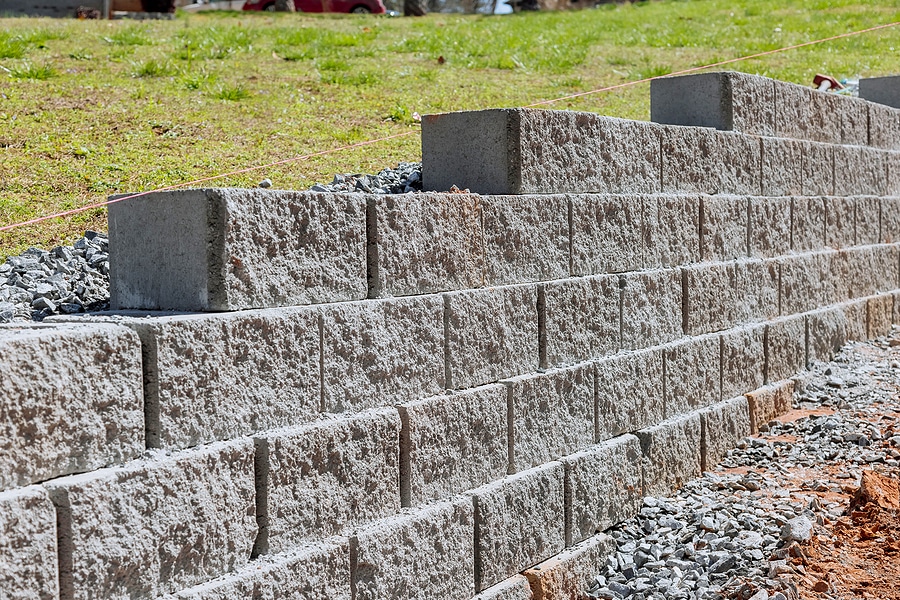Retaining Wall Checklist: Everything to prep before installing OKC Precision Retaining Walls
Secret Considerations for Building Effective Retaining Walls in Your Backyard
When you're thinking about constructing a keeping wall in your lawn, it's crucial to believe concerning a number of vital factors. The wall surface's purpose, the products you'll use, and the particular soil problems can all influence its effectiveness and durability.
Recognizing the Objective of Your Retaining Wall
When you think of developing a preserving wall, consider its major purpose: maintaining soil and stopping disintegration. Retaining walls supply essential assistance for sloped landscapes, assisting to maintain soil honesty. You'll locate they're essential in areas where water overflow may or else clean away dirt, causing expensive repair work and landscape damage.
By keeping back planet, these walls produce degree surface areas for yards, patios, or pathways. This not only boosts your yard's visual appeals yet also promotes better water drainage, reducing water merging in undesirable areas. If you're handling high slopes, a well-constructed retaining wall can stop landslides, making certain safety and security for you and your property.
Ultimately, understanding the objective of your retaining wall surface will certainly guide your design decisions and assist you produce a practical, resilient structure that meets your demands. Take a minute to evaluate your landscape; it'll pay off in the lengthy run.
Selecting the Right Products
When selecting materials for your retaining wall, you'll wish to think about toughness, looks, and price. Each element plays a necessary role in ensuring your wall surface stands the examination of time while looking wonderful and fitting your budget plan. Let's discover just how to make the ideal options for your job.
Product Longevity Variables
Selecting the ideal products is important for the longevity and performance of your retaining wall, since their longevity directly impacts the wall's ability to withstand ecological tensions. Beginning by considering your regional environment; materials like concrete and rock resist dampness and temperature level fluctuations well. If you reside in a location susceptible to hefty rains, select products with excellent drain homes, like crushed rock or porous blocks, to stop water buildup.
Some products perform far better in certain dirt types, so it's important to match them as necessary. Choosing sturdy products guarantees your retaining wall surface stands strong, protecting your lawn for years to come.
Aesthetic Layout Options
Durable materials not only ensure your retaining wall surface's structural integrity yet likewise play a vital duty in its visual allure. When choosing the right products, assume concerning exactly how they complement your landscape. Natural rock uses a timeless, rustic look, while cinder block can supply a streamlined, modern-day surface. You may likewise think about utilizing lumber for a warm, organic feel. Shade and structure matter, as well; select shades that harmonize with your home and yard. Do not fail to remember regarding the wall's shape-- curved walls can create a softer look, while straight lines can feel much more organized. By thoroughly choosing products that line up with your aesthetic vision, you'll boost your exterior room while ensuring your wall stands solid against the elements.
Cost-Effectiveness Analysis
Picking the ideal materials for your retaining wall isn't nearly visual appeals; it's additionally vital for your budget plan. When choosing materials, take into consideration both in advance expenses and long-lasting longevity. Concrete blocks might be more expensive originally, but their durability can conserve you cash on repair services. On the other hand, wood can be more economical however might need substitute earlier.
Do not neglect to consider maintenance costs as well (OKC Precision Retaining Walls). Some products, like all-natural rock, can include appeal and require less upkeep, while others might need regular treatments
Ultimately, weigh the advantages and disadvantages of each option against your budget and the wall surface's desired objective. Spending sensibly in products now can stop costly problems later on. Select materials that stabilize price and efficiency successfully.
Assessing Dirt Problems and Water Drainage
As you begin your project, evaluating dirt problems and drain is necessary for the success of your retaining wall surface. Begin by examining the type of dirt in your yard. Sandy dirt drains well however does not have stability, while clay soil can retain wetness, causing press on your wall. Test the soil's moisture material by digging a small opening and observing how quickly it dries.
Next, analyze the incline of your lawn. If water naturally streams toward your wall, you'll require to execute a drainage option to avoid disintegration and pressure build-up. Think about setting up perforated pipelines or gravel backfill behind the wall surface to facilitate water drainage.
Lastly, observe any type of neighboring trees or greenery; their origins can impact soil security. By understanding your dirt problems and executing proper water drainage, you'll create a solid structure for your retaining wall surface that stands the test of time.
Adhering To Local Building Ordinance
Before you begin building your retaining wall, you require to study local regulations to ensure conformity. It's important to understand what permits you need to get, as this can conserve you from costly fines or their explanation needing to remodel your work. Taking these steps seriously will assist you develop a risk-free and reliable structure.
Research Local Rules
Comprehending local laws is necessary when preparing your retaining wall surface task, particularly because constructing codes can vary greatly by place. Look for standards on wall elevation, materials, drainage systems, and structural honesty. By doing your research study upfront, you can assure your retaining wall satisfies all necessary codes and blends seamlessly right into your backyard.
Get Required Authorizations
Once you've looked into regional laws, the next action is to obtain the needed authorizations for your retaining wall job. This process warranties your wall conforms with structure codes and safety and security standards. Get to out to your neighborhood structure authority to figure out what allows you require. They may need certain strategies or design assessments, especially for bigger walls. Be prepared to submit thorough illustrations, including dimensions and materials. Don't forget to inspect if your task influences drainage or neighboring properties, as these factors might need extra authorizations. Safeguarding the appropriate approvals can save you from costly fines or needing to dismantle your wall later. Bear in mind, following the rules now will certainly bring about a smoother construction experience.

Planning the Design and Visual Appeal
As you commence intending the style and visual appeals of your retaining wall, take into consideration exactly how it will certainly integrate with the bordering landscape. Consider the products you'll use-- stone, block, or concrete-- and exactly how they'll match your home's architecture and the natural elements in your backyard. Pick shades and structures that mix effortlessly with existing features like patio areas, pathways, or yards.
Next, visualize the wall's form and height. Rounded walls can soften a rigid landscape, while straight lines might communicate an extra contemporary look. Do not forget to integrate plants and plant around the wall for an all-natural touch; this can enhance its charm and integrate it right into the atmosphere.
Lastly, keep in mind capability. Your design must not only be visually pleasing yet likewise serve its purpose efficiently. By attentively planning these aspects, you'll visit our website create a preserving wall that boosts your yard's charm while meeting its architectural role.
Determining Elevation and Density Demands
To construct a durable retaining wall surface, you need to accurately calculate its elevation and density demands based upon the dirt conditions and the elevation of the slope it will certainly support. Beginning by reviewing the incline's angle and the kind of soil, as different soils apply differing quantities of pressure.
For walls over four feet high, think about a thickness of at the very least 12 inches. If the wall surface is taller, enhance the density proportionally to keep stability.
Following, calculate the height of the wall by determining the upright range it requires to preserve. For every foot of height, you should normally prepare for a thickness of one-third of the wall surface's elevation.
Constantly bear in mind to make up added variables like drainage and backfill, which can affect your wall surface's layout. Correct estimations currently ensure your retaining wall stands strong and lasts for years to find.
Maintenance and Longevity Considerations
While maintaining your retaining wall surface could look like a low concern, disregarding it can bring about substantial problems in time. Regular inspections are important; look for splits, bulges, or any type of signs of water damages. Attending to these issues early can save you from pricey repair services later on.
Maintain an eye on drain systems, as well. Clogged drains pipes can cause water to develop, putting in pressure on your wall surface and jeopardizing its stability. Clear particles and assurance proper circulation to maintain long life.
You may also intend to reflect on securing your wall to secure it from wetness and weathering. Relying on the material, this may need reapplication every couple of years.
Last but not least, landscape design around your wall surface can sustain its integrity. Prevent planting big trees nearby, as their roots can threaten the foundation. With aggressive maintenance, your retaining wall surface can serve you well for several years to come.

Often Asked Questions
Can I Build a Retaining Wall by Myself, or Should I Work with a Specialist?
You can definitely construct a maintaining wall on your own if you have the right devices and knowledge. Nevertheless, working with a professional assurances it's done correctly, particularly for larger or more complex structures. Consider your skill degree prior to deciding.
What Are the Most Typical Errors Made When Structure Retaining Walls?
When constructing anonymous retaining walls, you could overlook appropriate drain, avoid utilizing the appropriate products, or forget reinforcement. These usual mistakes can cause architectural failing, so take your time and strategy meticulously to stay clear of concerns.
Just how Do I Know if My Retaining Wall Demands Support?
You'll recognize your retaining wall needs reinforcement if you notice cracks, leaning, or bulging. Look for water merging behind it or dirt disintegration near the base. Address these signs immediately to stop additional damage.
What Plants Are Suitable for Landscaping Around a Retaining Wall?
When landscaping around a retaining wall surface, take into consideration using low-maintenance plants like succulents, ornamental turfs, or creeping ground covers - OKC Precision Retaining Walls. They'll thrive in those conditions and add beauty while preventing soil erosion around your wall
Just How Can I Protect Against Disintegration Around My Retaining Wall?
To stop erosion around your retaining wall surface, you can grow ground cover, use compost, and mount water drainage systems. Routinely check for water build-up and change landscaping to reroute overflow away from the wall surface.